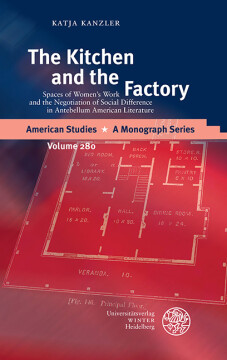
BUCH
The Kitchen and the Factory
Spaces of Women’s Work and the Negotiation of Social Difference in Antebellum American Literature
American Studies – A Monograph Series, Bd. 280
2017
Zusätzliche Informationen
Bibliografische Daten
Abstract
This book asks for the cultural work that spaces of feminine labor do in antebellum texts from a variety of literary and ‘para-literary’ contexts. Singling out the kitchen and the factory, it argues that sites of women’s work serve as key textual microcosms in which antebellum culture negotiates the discourses of social difference whose relevance skyrockets in this period, especially the discourses of gender, class, ‘race,’ and nationhood. Because of their ostensible marginality on the map of the national imaginary, and because they are associated with social subjects multiply marked as marginal—women of the ‘working class’ and slave women—the kitchen and the factory enable the rehearsal of ideas that are difficult to articulate within the core narratives of nationhood: ideas about the forms and meanings of social inequality, and their relationship to the promises of equality that suffuse the nation’s mythology.
Inhaltsverzeichnis
| Zwischenüberschrift | Seite | Aktion | Preis |
|---|---|---|---|
| Cover | Cover | ||
| Titel | 3 | ||
| Imprint | 4 | ||
| Table of Contents | 5 | ||
| Acknowledgments | 7 | ||
| 1 Introduction: Kitchen and Factory | 9 | ||
| 2 Theories, Histories, Contexts | 17 | ||
| 2.1 The Poetics and Politics of (Built) Space | 17 | ||
| 2.2 Rehearsals of Class: Social Inequality in Antebellum Literature and Culture | 29 | ||
| 3 The Kitchen | 43 | ||
| 3.1 The Kitchen, I: The House of Bondage | 47 | ||
| 3.1.1 ‘White’ Perspectives: Stove, Eastman, Hale | 49 | ||
| 3.1.2 ‘Black’ Perspectives: Jacobs and Wilson | 82 | ||
| 3.1.3 A Southern Cookbook | 92 | ||
| 3.2 The Kitchen, II: ‘Free’ Homes | 98 | ||
| 3.2.1 "The Lamplighter" and “The Cook's Dream" | 100 | ||
| 3.2.2 Didactic Domestic Novels | 112 | ||
| 3.2.3 Northern Cookbooks | 137 | ||
| 4 The Factory | 155 | ||
| 4.1 ‘Looking In | 161 | ||
| 4.1.1 Travelogues | 161 | ||
| 4.1.2 Sensation Novels | 174 | ||
| 4.2 ‘Looking Out‘ | 188 | ||
| 4.2.1 ‘Realism‘ | 192 | ||
| 4.2.2 Arrivals | 201 | ||
| 4.2.3 Windows and Machines | 202 | ||
| 4.2.4 Home | 210 | ||
| 4.3 Aestheticizing the Factory | 234 | ||
| 4.3.1 “The Tartarus of Maids" | 236 | ||
| 4.3.2 “Life in the Iron Mills" | 245 | ||
| 5 Conclusion | 257 | ||
| 6 Illustrations | 260 | ||
| 7 Works Cited | 262 |


 Publishing Platform by CloudPublish
Publishing Platform by CloudPublish